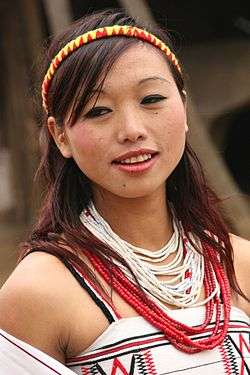Apatani people
The Apatani, or Tanw, are a tribal group of people living in the Ziro valley in the Lower Subansiri district of Arunachal Pradesh in India.[1]
Tanw, Apatani, Apa Tani | |
|---|---|
Diorama of Apatani people in Jawaharlal Nehru Museum, Itanagar. | |
| Total population | |
| 80,000 (2011) | |
| Regions with significant populations | |
| Arunachal Pradesh, India: 80,000 | |
| Languages | |
| Apatani (Tanw), English , Hindi | |
| Religion | |
| Donyi-Polo, Christianity , Animism, | |
| Related ethnic groups | |
| Nyishi, Hill Miri , Adi |
Customs and lifestyle
Their wet rice cultivation system and their agriculture system are extensive even without the use of any farm animals or machines. So is their sustainable social forestry system. UNESCO has proposed the Apatani valley for inclusion as a World Heritage Site for its "extremely high productivity" and "unique" way of preserving the ecology.[2] They have two major festivals - Dree and Myoko. In July, the agricultural festival of Dree is celebrated with prayers for a bumper harvest and prosperity of all humankind. Paku-Itu, Daminda, Piree dance, etc., are the main cultural programmes performed in the festival.[3] Myoko is a festival to celebrate friendship similar to modern friendship day but unlike the latter which lasts only for a day, it is celebrated for almost a month long, from the end of March to the end of April. Apatanis trace their descent patrilineally.
The Apatanis, one of the major ethnic groups of eastern Himalayas, have a distinct civilization with systematic land use practices and rich traditional ecological knowledge of natural resources management and conservation, acquired over the centuries through informal experimentation. The tribe is known for their colorful culture with various festivals, intricate handloom designs, skills in cane and bamboo crafts, and vibrant traditional village councils called bulyañ. This has made Ziro Valley a good example of a living cultural landscape where man and environment have harmoniously existed together in a state of interdependence even through changing times, such co-existence being nurtured by the traditional customs and spiritual belief systems.[4]
 An Apatani woman with a basket going to field.
An Apatani woman with a basket going to field.
References
- Blackburn, Stuart H. (1 January 2016). Into the Hidden Valley: A Novel. ISBN 9789385288906.
- "Unique Apatani impresses The Telegraph, 17 June 2005. URL last accessed 21 October 2006.
- NEZCC - North East Zone Cultural Centre Archived 12 January 2007 at the Wayback Machine
- Centre, UNESCO World Heritage. "Apatani Cultural Landscape - UNESCO World Heritage Centre". whc.unesco.org. Retrieved 26 April 2017.
External links
| Wikimedia Commons has media related to Apatani people. |
Further reading
- von Fürer-Haimendorf, Christopher. (1962) The Apa Tanis and Their Neighbors. New York: The Free Press of Glencoe.
